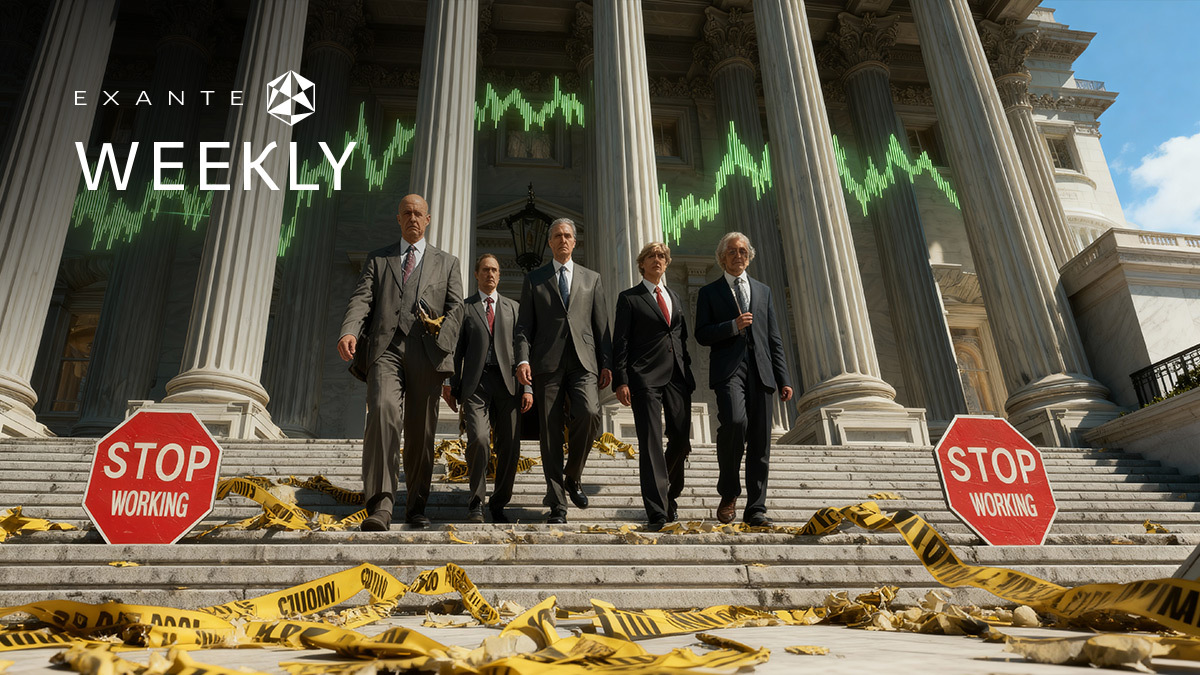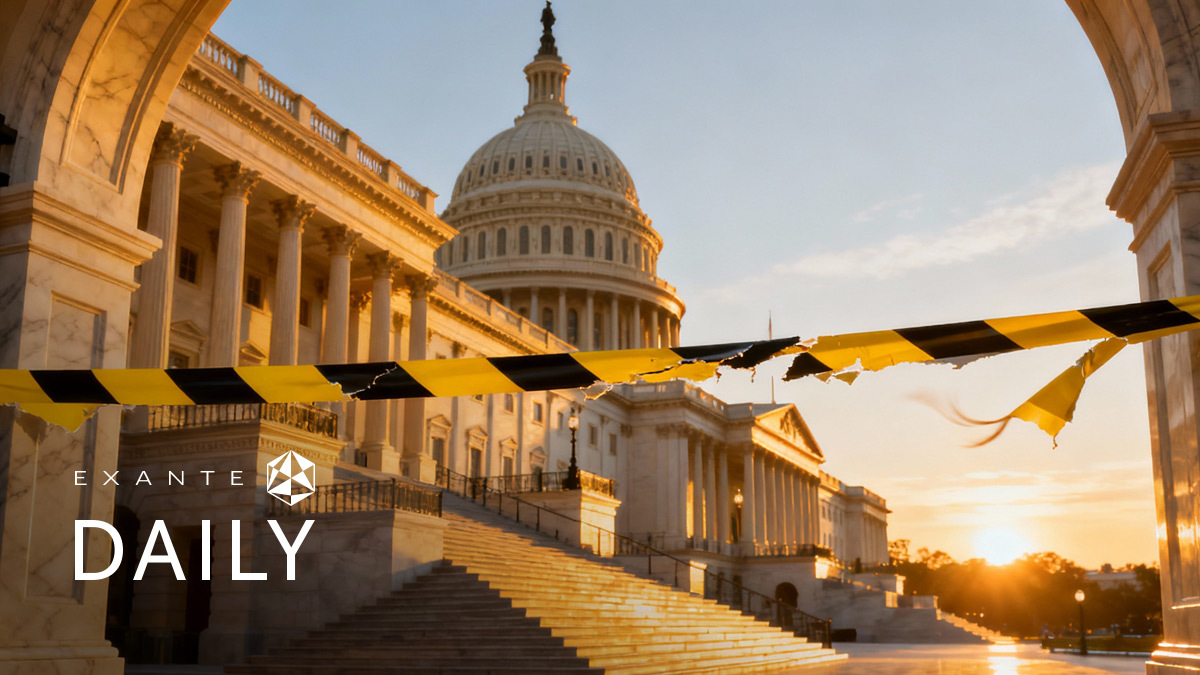
Will the UK sail into stagflation?

Key data to move markets today
UK: A speech by BoE Chief Economist Huw Pill.
US: UoM 1-year and 5-year Inflation Expectations Surveys and a speech by St Louis Fed President Alberto Musalem.
Japan: Current Account.
US Stock Indices
Dow Jones Industrial Average -0.51%.
Nasdaq 100 +3.66%.
S&P 500 -0.08%, with 5 of the 11 sectors of the S&P 500 down.
US stock markets saw a mixed performance on Thursday following the implementation of new tariffs. The Dow Jones Industrial Average fell by 224 points, or -0.51%, to 43,968, reflecting market apprehension over the new trade policies. The S&P 500 saw a slight decline of -0.08%, while the Nasdaq Composite gained +0.35% to close at a new record high.
In corporate news, UnitedHealth Group and Amedisys overcame legal challenges to reach a proposed settlement with the US Justice Department regarding their $3.3 billion merger.
General Motors announced a strategic move to procure electric-vehicle batteries from China for its new entry-level EV models. This is a temporary measure until it can secure a supply of US-made batteries through its partnership with LG Energy Solution.
Warner Bros. Discovery, the parent company of HBO and CNN, reported a profitable Q2, driven by strong box office performance.
DoorDash, the largest food delivery service in the US, provided an optimistic outlook for its Q3 orders that exceeded Wall Street expectations.
According to the Wall Street Journal, activist investor firm Starboard Value has acquired a stake of over 9% in the engineering-materials maker Rogers and reportedly plans to push for additional changes to boost the company's value.
S&P 500 Best performing sector
Utilities +1.05%, with NRG Energy +3.14 %, Nextera Energy +2.89 %, and Vistra +2.36%.
S&P 500 Worst performing sector
Health Care -1.15%, with Eli Lilly & Co -14.14%, McKesson -5.76%, and Vertex Pharmaceuticals -2.60%.
Mega Caps
Alphabet +0.18 %, Amazon +0.37%, Apple +3.17 %, Meta Platforms -1.32%, Microsoft -0.78%, Nvidia +0.75 %, and Tesla +0.74 %.
Information Technology
Best performer: Arista Networks +17.49%.
Worst performer: Fortinet -22.03%.
Materials and Mining
Best performer: International Paper +3.69%.
Worst performer: Ball -3.22%.
European Stock Indices
CAC 40 +0.97%.
DAX +1.12%.
FTSE 100 -0.69%.
Corporate Earnings Reports
Posted on Thursday, 7th August
- Eli Lilly and Co. quarterly revenue +37.6% to $15.558 bn vs. $14.704 bn estimate.
EPS at $6.31 vs. $5.60 estimate.
David A. Ricks, Chair and CEO, said, “Lilly delivered another quarter of strong performance, achieving 38% year-over-year revenue growth driven by robust sales of Zepbound and Mounjaro and sustained momentum across our key medicines. Our pipeline continued to advance, highlighted by positive study results in oncology and cardiometabolic health—including Mounjaro's demonstrated cardio-protective effects in patients with type 2 diabetes and heart disease and strong data for our oral incretin, orforglipron, in obesity. We also expanded manufacturing capacity to meet increasing demand and invested in key R&D initiatives to support our long-term growth.” — see report.
- ConocoPhillips quarterly revenue +4.3% to $14.740 bn vs. $14.679 bn estimate.
EPS at $1.42 vs. $1.35 estimate.
Ryan Lance, chairman and CEO, said, “In the second quarter, we delivered strong results financially, operationally and strategically. We completed the integration of Marathon Oil and remain on track to deliver greater than $1 billion in synergies and more than $1 billion of one-time benefits. We are leveraging our scale and technologies to drive a further $1 billion-plus in company-wide cost reductions and margin enhancements by the end of 2026. These efforts strengthen our free cash flow generation, enabling us to continue delivering strong returns on and of capital.” — see report.
- Expedia quarterly revenue +6.4% to $3.786 bn vs. $3.708 bn estimate.
EPS at $4.24 vs. $3.97 estimate.
Ariane Gorin, CEO, said, “We delivered a solid second quarter, surpassing our top and bottom line expectations while navigating a dynamic environment. Our performance was driven by continued strength across B2B and Advertising and further progress on our key priorities. Based on our first half and ongoing trends, we have increased our annual guidance. We will continue to capitalize on our brands, supply, and technology to help travelers create memories and partners grow their businesses.” — see report.
Commodities
Gold spot +0.87% to $3,397.34 an ounce.
Silver spot +1.23% to $38.31 an ounce.
West Texas Intermediate -0.76% to $63.82 a barrel.
Brent crude -0.64% to $66.35 a barrel.
On Thursday, gold prices reached their highest point in over two weeks, driven by heightened demand for safe-haven assets following the implementation of US tariffs.
The price of spot gold settled +0.87% to $3,397.34 per ounce after peaking earlier in the trading session to its highest level since 23rd July.
Oil prices experienced their sixth consecutive daily decline on Thursday amid mounting expectations of a diplomatic resolution to the conflict in Ukraine. The shift was triggered by the Kremlin's announcement that Russian President Vladimir Putin would meet with US President Donald Trump in the coming days. This would mark their first summit since 2021.
Both major crude benchmarks reached eight-week lows. Brent crude futures settled down by 43 cents, or -0.64%, at $66.35 per barrel, while WTI crude fell by 49 cents, or -0.76%, to $63.82.
Despite the decline in oil prices, which has seen oil prices fall by over nine percent in the past week, other factors limited further losses. These included a decrease in US crude stockpiles, an increase in Saudi Arabian oil prices for Asian markets, and robust Chinese crude imports in July.
Data from the US EIA showed on Wednesday that domestic crude inventories dropped by 3 million barrels in the week ending 1st August.
Additionally, while Chinese crude imports in July decreased by 5.4% from the previous month, they were still up 11.5% compared to the same period last year.
Saudi Arabia, the world's largest oil exporter, had raised its September crude prices for Asian buyers for the second consecutive month, citing tight supply and strong demand.
Note: As of 5 pm EDT 7 August 2025
Currencies
EUR +0.05% to $1.1663.
GBP +0.61% to $1.3437.
Bitcoin +1.98% to $117,367.98.
Ethereum +5.27% to $3,875.59.
The US dollar edged down on Thursday. Bloomberg news reported that Fed Governor Christopher Waller has emerged as a leading candidate for Fed Chair among the US President’s team. According to Bloomberg news, Waller has met with the team, but not the President, and has left a favourable impression. President Trump had stated he narrowed his search for a new Fed chair to four individuals.
In a separate move, Trump nominated Stephen Miran to replace Adrian Kugler, who resigned last Friday, on the Fed's Board of Governors. Miran would serve the remainder of Adriana Kugler's term, which expires 31 January 2026.
The New York Fed reported that Americans' longer-term inflation expectations worsened in July, even as their views on personal financial situations improved. Atlanta Fed President Raphael Bostic stated that while risks to the job market have increased, it is premature to commit to interest rate cuts, especially with key data still pending and inflation expected to rise in the coming months.
The US dollar declined -0.11% to 98.08 on Thursday. The euro edged up +0.05% to $1.1663. Earlier in the day, buoyed by positive sentiment regarding diplomatic talks aimed at resolving the conflict in Ukraine, the euro hit a one-week high of $1.1698.
The British pound strengthened on Thursday, rising +0.61% to $1.3437. This was a direct result of the BoE’s latest policy decision. While the BoE implemented a widely anticipated 25 bps rate cut, a larger-than-expected number of policymakers — four of nine — voted to keep rates unchanged, signalling concerns about high inflation and warning that the scope to cut rates further looks limited.
For the first time in its history, the MPC of the BoE required two votes as during the first vote four of its nine policymakers voted to keep rates unchanged, four voted for a 25 bps cut, and one policymaker supported a larger 50 bps cut.
This divided vote was more hawkish than the market had anticipated and suggests that the BoE's cycle of rate cuts may be nearing an end. Britain faces a complex economic landscape where a softening jobs market, weaker pay growth and rising inflation create a dilemma for policymakers, some of whom favour controlling inflation over supporting economic growth.
Against the Japanese yen, the dollar declined by -0.20% to ¥147.04.
Fixed Income
US 10-year Treasury +2.7 basis points to 4.259%.
German 10-year bund -1.7 basis points to 2.633%.
UK 10-year gilt +1.7 basis points to 4.550%.
US Treasury yields saw modest increases on Thursday, largely due to a string of lackluster bond auctions throughout the week. A particularly weak auction of 30-year bonds was the main driver, capping a session that had seen yields fluctuate.
The yield on the 10-year Treasury note rose by +2.7 bps to 4.259%. The 30-year bond yield also saw an increase, gaining +1.6 bps to 4.808%, while the two-year Treasury yield advanced +1.6 bps to 3.736%.
Earlier in the week, yields had been moving downward, boosted by July’s weak NFP report and the announcement of Fed Governor Adriana Kugler's resignation from the Fed. These developments heightened market expectations for a rate cut at the FOMC September meeting.
However, this downward momentum stalled on Tuesday following a soft auction of $58 billion in three-year notes. This continued with Wednesday's $42 billion 10-year auction and culminated in Thursday's poor 30-year bond sale, which had a bid-to-cover ratio of 2.27x, the lowest since November 2023.
Additionally, yields reversed from their session lows after Bloomberg news reported that Fed Governor Christopher Waller is a top candidate for Fed Chair.
Fed funds futures traders are now pricing in a 91.4% probability of a rate cut in September, up from 80.3% last week, according to CME Group's FedWatch Tool. Traders are currently anticipating 59.3 bps of cuts by year-end, higher than the 58.1 bps expected last week.
Across the Atlantic, yield curves in the eurozone flattened slightly on Thursday as longer-dated yields fell more significantly than their shorter-dated counterparts.
Germany's 10-year bond yield decreased by -1.7 bps to 2.633%, while its 2-year yield saw a smaller decline of -1.4 bps and the 30-year yield dropped by -3.1 bps.
Investors currently see a very low probability of a ECB rate cut at its next meeting and are not fully pricing in any further cuts for this cycle.
In the UK, the BoE's fifth rate cut since August of last year led to volatile trading. While BoE reduced its key rate by 25 bps as anticipated, a surprising vote split among policymakers suggested that a further cut this year is less certain than previously thought.
Britain's rate-sensitive two-year yield rose by +4.7 bps to 3.884%, while the 10-year gilt yield increased by +1.7 bps to 4.550%. The 30-year yield, however, saw a slight decline of -0.7 bps to 5.356%. Money markets now anticipate a 75% chance of another BoE rate cut this year, a decrease from previous expectations.
Throughout the eurozone, bond yields largely tracked Germany's 10-year yield. This was supported by strong demand at recent bond auctions in France and Spain.
France's 10-year yield was down -0.7 bps to 3.304%, and Italy's 10-year yield declined by -1.2 bps to 3.434%. The spread between German and Italian 10-year yields stood at 80.1 bps.
Note: As of 5 pm EDT 7 August 2025
Global Macro Updates
BoE’s surprising hawkish rate cut. The BoE MPC voted 5 - 4 to reduce its key Bank Rate by 25 bps to 4.00% on Thursday. This marked the first time the MPC required two votes to reach a consensus. During the first vote four members voted for a 25 bps cut, four dissented in favour of maintaining the rate at its current level and a fifth member, Alan Taylor, advocated for a larger 50 bps reduction.
The official statement from the BoE reaffirmed its commitment to a ‘gradual and careful’ approach to easing monetary policy. The timing and pace of any future rate cuts will be contingent on the continued easing of underlying disinflationary pressures. This has fuelled market speculation that the rate-cutting cycle could potentially pause toward the end of the year, leading investors to scale back their expectations for further cuts. The BoE emphasised that its policy is not on a ‘preset path.’
In its updated forecasts, the BoE projects inflation will peak at 4.0% in September, a rise from its previous forecast of 3.7%. This revision is attributed to factors such as higher payroll taxes, an increase in the minimum wage, a new packaging tax, and elevated global prices. The BoE also upgraded its 2025 GDP growth forecast to 1.25% from 1.0%, while keeping its 2026 and 2027 projections unchanged at 1.25% and 1.5%, respectively. These macroeconomic projections are based on an implied key rate of 3.8% in Q4 2025, 3.5% in 2026, and 3.6% in 2027.
The BoE’s cut came amid growing speculation that Chancellor of the Exchequer Rachel Reeves will be forced to raise taxes in the autumn Budget to balance public finances including a reported £50 bn ‘black hole’ amid slowing growth.
While every effort has been made to verify the accuracy of this information, EXT Ltd. (hereafter known as “EXANTE”) cannot accept any responsibility or liability for reliance by any person on this publication or any of the information, opinions, or conclusions contained in this publication. The findings and views expressed in this publication do not necessarily reflect the views of EXANTE. Any action taken upon the information contained in this publication is strictly at your own risk. EXANTE will not be liable for any loss or damage in connection with this publication.
Ten artykuł jest publikowany wyłącznie w celach informacyjnych i nie powinien być traktowany jako oferta lub zachęta do kupna lub sprzedaży jakichkolwiek inwestycji lub powiązanych usług, do których można się tu odwołać. Obrót instrumentami finansowymi wiąże się ze znacznym ryzykiem strat i może nie być odpowiedni dla wszystkich inwestorów. Wyniki osiągnięte w przeszłości nie są wiarygodnym wskaźnikiem wyników w przyszłości.
Zarejestruj się i otrzymuj informacje rynkowe
Zarejestruj się i otrzymuj
informacje
rynkowe
Subskrybuj teraz



